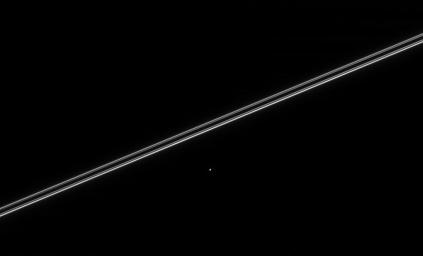
|
Dione’s Companion
- Click the image above for a larger view
- Full-Res JPEG (974 x 590) (16.8 kB)
- Full-Res TIFF (974 x 590) (575.5 kB)
Caption:
Saturn's moon Helene, seen here with Saturn's nearly edge-on rings, orbits 60 degrees ahead of Dione and is called a "Trojan" moon. The tiny moon Polydeuces (about 5 kilometers or 3 miles across, recently discovered by Cassini imaging scientists) is also a Dione Trojan, orbiting 60 degrees behind. Helene is 32 kilometers (20 miles) across.
The image was taken in visible light with the Cassini spacecraft narrow-angle camera on March 12, 2005, at a distance of approximately 2 million kilometers (1.2 million miles) from Helene and at a Sun-Helene-spacecraft, or phase, angle of 90 degrees. Resolution in the original image was 10 kilometers (7 miles) per pixel.
Background Info:
The Cassini-Huygens mission is a cooperative project of NASA, the European Space Agency and the Italian Space Agency. The Jet Propulsion Laboratory, a division of the California Institute of Technology in Pasadena, manages the mission for NASA's Science Mission Directorate, Washington, D.C. The Cassini orbiter and its two onboard cameras were designed, developed and assembled at JPL. The imaging team is based at the Space Science Institute, Boulder, Colo.
For more information about the Cassini-Huygens mission, visit http://saturn.jpl.nasa.gov and the Cassini imaging team home page, http://ciclops.org .
Cataloging Keywords:
| Name | Value | Additional Values |
|---|---|---|
| Target | Saturn | Dione, Helene, Polydeuces, Saturn Rings |
| System | Saturn | |
| Target Type | Planet | Ring, Satellite |
| Mission | Cassini-Huygens | |
| Instrument Host | Cassini Orbiter | |
| Host Type | Orbiter | |
| Instrument | Imaging Science Subsystem (ISS) | |
| Detector | Narrow Angle Camera | |
| Extra Keywords | Grayscale, Visual | |
| Acquisition Date | ||
| Release Date | 2005-05-02 | |
| Date in Caption | 2005-03-12 | |
| Image Credit | NASA/JPL/Space Science Institute | |
| Source | photojournal.jpl.nasa.gov/catalog/PIA06639 | |
| Identifier | PIA06639 | |
